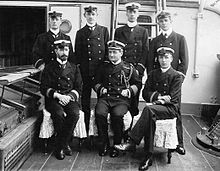Cyprian Bridge
| Sir Cyprian Bridge | |
|---|---|

Admiral Sir Cyprian Bridge, Commander-in-Chief, China Station, with staff in 1902
|
|
| Born | 13 March 1839 St. John's, Newfoundland |
| Died |
16 August 1924 (aged 85) Kingston Hill, Surrey |
| Allegiance |
|
| Service/branch |
|
| Rank | Admiral |
| Commands held | HMS Colossus |
| Battles/wars |
Crimean War World War I |
| Awards | Knight Grand Cross of the Order of the Bath |
Admiral Sir Cyprian Arthur George Bridge GCB (13 March 1839 – 16 August 1924) was a British Royal Navy officer towards the end of the era of Pax Britannica. He was Commander-in-chief of both the Australian Squadron and the China Squadron.
Bridge's father was Thomas Hobday Bridge, later Archdeacon of St. John's. His maternal grandfather was John Dunscombe, an aide-de-camp to the governor of Newfoundland. From 1851 Bridge attended school at Walthamstow House in England.
Bridge was nominated for the navy by Admiral Cochrane, to whom his father had been chaplain. He passed the navy entrance examination in 1853, and was appointed to the paddle sloop HMS Medea and later to the third-rate ship of the line HMS Cumberland, flagship of the North American Station.
During the Crimean War, Bridge served as a naval cadet in the White Sea. In Autumn 1854, a squadron of three warships led by the sloop HMS Miranda shelled and destroyed Kola. An attempt to storm Arkhangelsk proved abortive, as was the siege of Petropavlovsk in Kamchatka. While the Anglo-French naval squadron successfully shelled the town, a landing of 800 sailors and marines was repulsed.
...
Wikipedia
